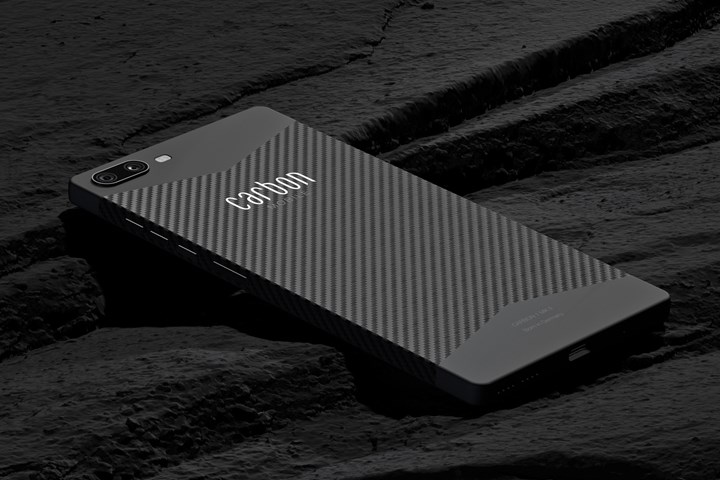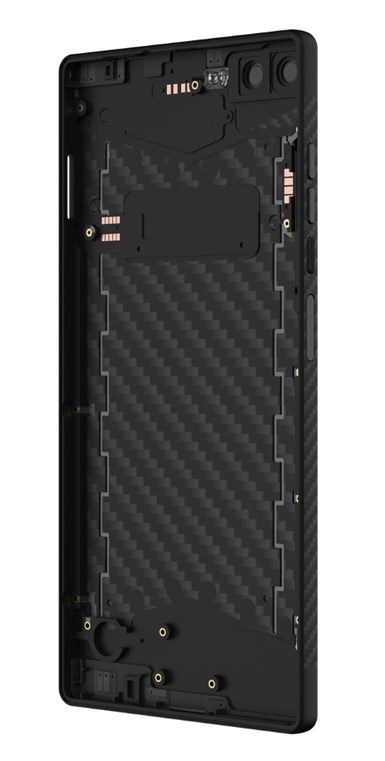Carbon Mobile carbon fiber smartphone unlocks RF signal permeation capabilities
Housing is made from Lanxess Tepex thermoplastics reinforced with 1K continuous carbon fiber using Carbon Mobile’s patented HyRECM process for a “radio-enabled” composite material.

Photo Credit: Lanxess
Lanxess (Cologne, Germany) reported on March 16 that the Carbon 1 MK II smartphone being debuted this month by startup company Carbon Mobile (Berlin, Germany) has replaced plastics and aluminum with advanced composite materials. Said to be first carbon fiber smartphone, the base material for the production of the housing is a thermoplastic composite from the Lanxess Tepex dynalite product range, and is reinforced with 1K continuous carbon fiber filaments for a light, slim design that is made 5% less plastic.
“Our composite material, which we developed for lightweight components subjected to considerable mechanical stress, does more than just allow exceptionally thin wall thicknesses. In fact, with its high degree of strength and rigidity, it also helps to make the housing very robust for day-to-day use,” explains Philipp Genders, Tepex expert in application development at Lanxess. “In addition, the matte-black carbon fibers give the smartphone a truly high-tech look.”
However, Carbon Mobile says, use of carbon fiber initially had its challenges. The company notes that, despite their advanced properties for producing robust yet lightweight structures, carbon fibers are effective against electromagnetic shielding, which means that, rather than allowing radio signals to pass through, the material disperses them around the outer body of the device. Connected devices with carbon fiber, for this reason have been viewed as a road block by the tech industry.
Nonetheless, the Carbon 1 MK II smartphone follows four years of research and development by Carbon Mobile’s engineers, which resulted in the HyRECM (Hybrid Radio Enabled Composite Material) technology, a patented process that fuses carbon fibers together with a complementary composite material capable of radio frequency (RF) signal permeation. To further boost the devices’ connectivity, a 3D-printed conductive ink is integrated into the carbon fiber structure. Carbon Mobile claims this has resulted in the first “radio-enabled” carbon fiber-based material.

Carbon 1 MK II carbon fiber monocoque. Photo Credit: Lanxess
“Lanxess and their Tepex materials made the perfect partner in the development of HyRECM Technology,” say Eric Chan from processing partner Modern Composites Ltd. (Hong Kong, China) says. “Being able to work with a superior material from Germany ensures the best application possible of this revolutionary technology from launch.”
Following the same construction principle as the load-bearing chassis of a Formula 1 car, the housing is designed as a monocoque, or “single shell” for high rigidity. Carbon Mobile says this contributes significantly to the thin wall thicknesses, light weight of the smartphone and also enables miniaturization because there is no bulky reinforcement taking up space on the inside of the housing. According to Firas Khalifeh, CEO of Carbon Mobile, “Our cutting-edge monocoque design enables a device that weighs only 125 grams, a third lighter than conventional smartphones. At just 6.3 millimeters, it is also 25% thinner as well.”
Carbon Mobile adds that it is committed to sustainable principles. The new smartphone uses only recyclable materials wherever possible. “We want to deliver our contribution to cutting electronic waste and improving sustainability around the world,” says Khalifeh.
The composite material used for the housing can also easily be recycled and repurposed for new uses. “Like all products in the Tepex dynalite product line, it can be shredded and then processed on standard injection molding machines to make high-quality components, either by itself or mixed with suitable new material,” adds Genders. To extend the service life of the smartphone, all its components are designed to be easily replaceable for repair purpose, which also prevents electronic waste.
Related Content
One-piece, one-shot, 17-meter wing spar for high-rate aircraft manufacture
GKN Aerospace has spent the last five years developing materials strategies and resin transfer molding (RTM) for an aircraft trailing edge wing spar for the Airbus Wing of Tomorrow program.
Read MoreCryo-compressed hydrogen, the best solution for storage and refueling stations?
Cryomotive’s CRYOGAS solution claims the highest storage density, lowest refueling cost and widest operating range without H2 losses while using one-fifth the carbon fiber required in compressed gas tanks.
Read MoreSulapac introduces Sulapac Flow 1.7 to replace PLA, ABS and PP in FDM, FGF
Available as filament and granules for extrusion, new wood composite matches properties yet is compostable, eliminates microplastics and reduces carbon footprint.
Read MoreThe state of recycled carbon fiber
As the need for carbon fiber rises, can recycling fill the gap?
Read MoreRead Next
Composites end markets: Energy (2024)
Composites are used widely in oil/gas, wind and other renewable energy applications. Despite market challenges, growth potential and innovation for composites continue.
Read MoreCW’s 2024 Top Shops survey offers new approach to benchmarking
Respondents that complete the survey by April 30, 2024, have the chance to be recognized as an honoree.
Read MoreFrom the CW Archives: The tale of the thermoplastic cryotank
In 2006, guest columnist Bob Hartunian related the story of his efforts two decades prior, while at McDonnell Douglas, to develop a thermoplastic composite crytank for hydrogen storage. He learned a lot of lessons.
Read More








.jpg;maxWidth=300;quality=90)

















